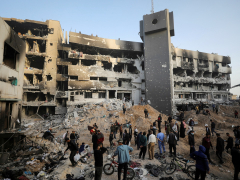In October, a video from Gaza began to circulate that horrified the world. It showed an injured teenager lying on a hospital gurney with an intravenous drip in his arm. As flames engulf him, he can do nothing but wave his arms in agony.
The fire that swallowed Shaban al-Dalou in front of our eyes, and that also killed his mother and younger brother and sister, was set off by a bomb dropped by the Israeli army on the courtyard of Al-Aqsa Martyrs Hospital in Deir el-Balah, where he was being treated for injuries sustained when he survived another Israeli bombing.
The video of al-Dalou’s death – likened by many observers to atrocity-defining images like the Pulitzer Prize-winning 1972 photograph of nine-year-old Phan Thị Kim Phúc being burned by US napalm in Vietnam – is far from an isolated nightmare.
Various forms of brutal death have taken place thousands of times across Gaza over the past 15 months, often as a result of US weapons provided to Israel by the United States government. These deaths are neither simply individual tragedies nor unintended consequences; they are symptoms of an Israeli strategy of total war and overwhelming horror inflicted against an entire people. This reality, and how we must respond to it, is nowhere clearer than at the ruins of Gaza’s hospitals.
MK-84 bombs and Gaza’s hospitals
A recent peer-reviewed study, of which one of us is a co-author, examined patterns in Israel’s bombing of the Gaza Strip during the first 40 days after October 7, 2023. It specifically analyses Israeli use of US-supplied Mark-84 bombs (MK-84s) around hospitals, which by international law and basic ethical imperatives, are afforded special protections against acts of war.
MK-84s are 2,000-pound (900kg) air-dropped explosives – otherwise known as “bunker busters” – designed to destroy infrastructure and kill human beings within hundreds of metres of where they land. They are weapons of indiscriminate destruction and annihilation, not “targeted strikes” against discrete targets.
Using geospatial data, the study found that Israel dropped MK-84s within blast range of more than 80 percent of hospitals in Gaza in just the first 40 days of its war, including one bomb that was dropped 14.7 metres (48 feet) from a hospital – effectively a direct hit.
Many hospitals had not just one but multiple of these massive bombs dropped around them. Two hospitals had more than 20 MK-84 bomb craters within 800 metres (the upper end of the MK-84’s infrastructural damage and serious injury blast range) of their facilities; another hospital had seven bomb craters within 360 metres (MK-84’s lethal range) of its patient wards. Thirty-eight MK-84s were detonated within the range of hospitals inside Israel-defined evacuation zones.
During this initial period of Israel’s acute destruction of Gaza, international controversy raged for weeks over the claim that Israel had bombed even a single hospital. The Israeli government and media along with their counterparts in the US and Europe repeatedly denied that Israel would attack hospitals – a violation of well-established humanitarian law. Simultaneously, enablers of Israeli violence that, shamefully, included senior US physicians and bioethicists, began publishing supposed justifications for any such possible action.
By December 2024, more than 1,000 Palestinian health workers were killed by Israeli attacks and unequivocal evidence shows that not just one but nearly all hospitals in Gaza have been deliberately and repeatedly targeted by the Israeli military armed with US weapons. What was once said to reflect an outrageous and libellous accusation is now taken for granted as a key component of everyday Israeli military conduct.
In May, in an implied recognition of this reality after eight months of watching Israel use thousands of US-supplied bombs to destroy heavily populated areas of Gaza and kill countless civilians, the Biden administration placed a hold on shipment of MK-84s to Israel, sending 500-pound (227kg) bombs instead. Last week, the Trump administration announced it is resuming shipment of MK-84s to Israel without any conditions.
A new paradigm: Horrorism
Philosopher Adriana Cavarero has written about such acts of horror through a framework she calls “horrorism”. With this term, she describes a form of impersonal violation rooted in disfiguration – like the burning alive of patients in hospital beds – and massacres, such as those we were witnessing on a daily basis in Gaza.
The concept of horrorism demands we approach violence not from the perspective of the perpetrator – as is often done in war – but of the victim. It is only the victim who has the authority to name violence, to decide its meaning and value. The figure of the defenceless victim is most clearly represented for Cavarero by children, such as the thousands of Palestinian children who have been mutilated and killed by Israeli soldiers and US weapons over the last 15 months.
The hope for horrorism as an ethical paradigm is that by displacing preoccupation with “terrorists” and reframing violence through the lens of the most vulnerable, or those most in need of care, we might end the endless-by-design “war on terror” that reproduces horror upon horror for the world’s mos





